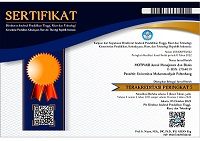Pengaruh Kualitas Layanan, Persepsi Nilai dan Kepuasan Nasabah terhadap Loyalitas Nasabah Bank
Abstract
perceived value and customer satisfaction on customer loyalty of
bank service in Palembang City.
Design/methodology - Data collected by questionnaire with the
number of respondents is 184 respondents and the approach of
sampling technique used is purposive sampling.
Findings – The result of the research explain that service quality
have positive and significant effect on customer loyalty. Perceived
value have a positive and significant effect on consumer loyalty.
Consumer satisfaction have a positive and significant effect on
consumer loyalty. Then, service quality, perceived value and
consumer satisfaction have a positive and significant effect on
consumer loyalty. The results showed that the convenience
provided by banking favored by consumers. Therefore, banks
should look for alternative strategies designed to improve services,
and interaction between bank employees and consumers.
Keywords
Full Text:
PDFReferences
Anderson, H. & Jacobsen, P.Q. (2000).Creating Loyalty: Its strategic importance in your customer strategy. S.A., 55-67.
Bolton, R. & Drew, J.H. (1991). A multistage model of consumers’ assessment of service quality and value. Journal of Consumer Research, 17(4), 375-384.
Bowen, J. T., & Shoemaker, S. (1998). Loyalty: a strategic commitment. Cornell Hotel and Restaurant Administration Quarterly, 39(1),12-25.
Bowen, J. T., & Chen, S. (2001). The Relationship between Customer Loyalty and Customer Satisfaction, International Journal of Contemporary Hospitality Management, 13(4), 213-217.
Brady, M.K. & Cronin, J. J. (2001). Some new thoughts on conceptualizing perceived service quality: a hierarchical approach, Journal of Marketing, 65, 34-49.
Caruana, A. (2002). Service Loyalty: The Effects of Service Quality and the Mediating Role of Customer Satisfaction. European Journal of Marketing, 36(7/8), 811–828.
Cheng, C. C., Chiu, S., Hu, H. & Chang, Y. (2011). A study on exploring the relationship between customer satisfaction and loyalty in the fast food industry: With relationship inertia as a mediator. African Journal of Business Management, 5(13): 5118-5126.
Choi, K. S, Cho, W. H, Lee S.H, Lee H.J, & Kim C.K. (2004). The Relationships among Quality, Value, Satisfaction and Behavioral Intention in Health Care Provider Choice: A South Korean Study. J. Bus. Res. 57(8), 913-921.
Churchill GA (1979). A paradigm for developing better measures of marketing constructs. J. Mark. Res. 16 (1), 64-73.
Cronin, J.J., Brady, M.K., & Hult, T.M., (2000). Assessing the effects of quality, value, customers satisfaction on consumer behavioural intentions in service environment, Journal of Retailing, 76 (2), 193-216.
Cronin, J. & Taylor, S. (1992). Measuring Service Quality: A Re-examination and Extension. Journal of Marketing, 56 (3), 55-68.
Cronin, Jr. J. Joseph & Taylor, Steven A. (1994). SERVPERF versus SERVQUAL: Reconciling performance-based and perceptions-minus-expectations measurement of service quality, Journal of Marketing, 58 (1), 25-31.
Dick, A. S., & Basu, K. (1994). Customer loyalty: toward an integrated conceptual framework. Journal of the Academy of Marketing Science, 22, 99-113.
Ghozali, Imam. (2005). Aplikasi Analisis Multivariate dengan SPSS. Semarang: Badan Penerbit UNDIP.
Hennig-Thurau Thorsten., Gwinner, Kevin P & Gremler, Dwayne D. (2002). Understanding Relationship Marketing Outcomes: An Integration of Relational Benefits and Relationship Quality. Journal of Service Research, 4 (3), 230-247.
Jamal, A & Kamal, N. (2004). Customer satisfaction and retail banking: an assessment of some of the key antecedents of customer satisfaction in retail banking, Int. J. Bank Mark, 20 (4), 146-160.
Jones, H & Farquhar, J. D. (2003). Contact Management and Customer Loyalty. Journal of Financial Services Marketing, 8(1), 71-78.
Kandampully, J., & Suhartanto, D. (2000). Customer Loyalty in the Hotel Industry: The Role of Customer Satisfaction and Image, International Journal of Contemporary Hospitality Management, 12 (6), 346-451.
Keaveney, S. M. (1995). Customer switching behavior in service industries: An exploratory study. Journal of Marketing, 59(2), 71-82.
Kim, W. G. & Cha, Y. (2002). Antecedents and consequences of relationship quality in hotel industry, International Journal of Hospitality Management, 21, 321-38.
Leverin, Andreas, & Liljander, Veronica. (2006). Does Relationship Marketing Improve Customer Relationship Satisfaction and Loyalty?, International Journal of Bank Marketing, 24 (4), 232-251.
Mazumdar, Tridib. (1993). A value based orientation to new product planning, Journal of Consumer Marketing, 10 (1), 28-41.
McMillan, J.H. (1992). Educational research: Fundamentals for the consumer. New York: Harper Collins Publishers.
Meidan, A. (1996). Marketing Financial Services: Hampshire and London: Macmillan Press Ltd
Mittal, Vikas & Kamakura, Wagner. (2001). Satisfaction, Repurchase Intent, and Repurchase Behavior: Investigating the Moderating Effect of Customer Characteristics. Journal of Marketing Research, 38(1): 131-142
Oliver R L. (1999). Whence Consumer Loyalty? Journal of Marketing, 63, 33-44.
Palmatier, Robert W., Rajiv P. Dant, Dhruv Grewal, & Kenneth R. Evans (2006). Factors Influencing the Effectiveness of Relationship Marketing: A Meta-Analysis. Journal of Marketing, 70, 136-53.
Parasuraman, A. Berry, L. & Zeithaml, V.A. (1988). SERVQUAL: A Multiple-Item Scale for Measuring Consumer Perceptions of Service Quality. Journal of Retailing, 64 (1), 12-40.
Parasuraman, A., Berry, L.L. & Zeithaml, V.A., (1991). Understanding Customer Expectations of Service. Sloan Management Review, 32 (3), 39-48.
Parasuraman, A. (1997). Reflections on gaining competitive advantage through customer value, Journal of the Academy of Marketing Science, 25 (2), 154-61.
Park, J. Robertson. R. & Wu, C. (2006). Modelling The Impact of Airline Service Quality and Marketing Variables on Passengers’ Future Behavioural Intentions, Transportation Planning and Technology, 29 (5) : 359-381.
Ranaweera, C., & Prabhu, J. (2003). On the relative importance of customer satisfaction and trust as determinants of customer retention and positive word of mouth. Journal of Targeting, Measurement and Analysis for Marketing, 12(1), 82-90.
Ravald, A., & Gronroos, C. (1996). The Value Concept and Relationship Marketing. European Journal of Marketing, 30(2), 19-30.
Reichheld, F.F. & Sasser, W.E. Jr (1990). Defections: quality comes to services, The Harvard Business Review, 106-107.
Reichheld, Fredrick F & Thomas, Teal. (1996). The Loyalty Effect. Boston, Mass.: Harvard Business School Press.
Roberts, K., Varki, S. & Brodie R. (2003). Measuring the quality of relationship in consumer services: An empirical study. European Journal of Marketing, 37,1/2, 169-197.
Rust, R. T., & Oliver, R. L. (1994). Service quality. Insights andmanagerial implications from the frontier. In R. T. Rust, & R. L. Oliver (Eds.), Service quality: new directions in theory and practice (pp. 1-19). Thousand Oaks, CA: Sage.
Sirdeshmukh, D., Singh, J., & Sabol, B. (2002). Consumer trust, value, and loyalty in relational exchanges. Journal of Marketing, 66,15-37.
Taylor, S. A., & Baker, T. L. (1994). An Assessment of the Relationship between Service Quality and Customer satisfaction in the Formation of Consumers’ Purchase Intentions. Journal of Retailing, 70 (2), 163-178.
Terblanche, N. S., & Boshoff, C. (2006). The relationship between a satisfactory in-store shopping experience and retailer loyalty. South Africa Journal of Business management, 37(2), 33-43.
Yi, Y. (1990). A critical review of consumer satisfaction, in Zeithaml, V. (Ed.): Review of Marketing, 1990, American Marketing Association, Chicago, IL, 68-123.
Zeithaml, V. A., Berry, L. L., & Parasuraman, A. (1996). The behavioral consequences of service quality. Journal of Marketing, 60 (2), 31-46.
Zeithaml, V. A. and Bitner, M.J. (2000). Services Marketing. McGraw Hill, New York.
Zineldin, M. (2006). The royalty of loyalty: CRM, quality and retention. Journal of Consumer Marketing, 23 (7), 430-437.
DOI: https://doi.org/10.32502/mti.v2i2.1960
Refbacks
- There are currently no refbacks.
Copyright (c) 2019 MOTIVASI Jurnal Manajemen dan Bisnis
Motivasi: Jurnal Manajemen dan Bisnis is Published by Management Department, Economic and Business Faculty, Muhammadiyah University of Palembang. This work is licensed under a Creative Commons Attribution-ShareAlike 4.0 International License.
Indexed/Abstracted






.png)
.png)



